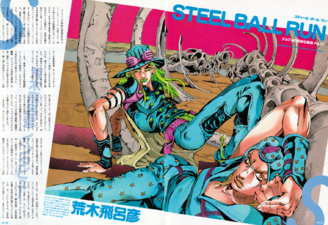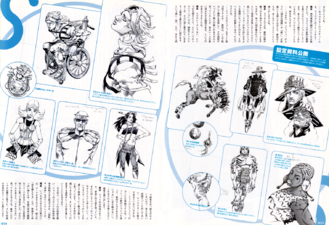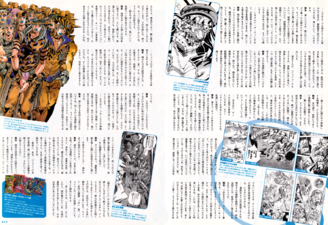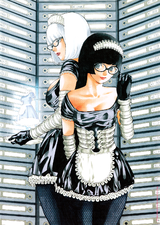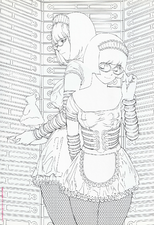Quarterly S (June 2005)
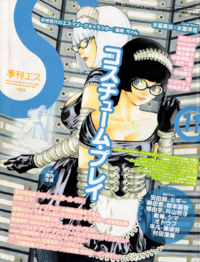
An interview with Hirohiko Araki about Steel Ball Run, published in the July issue of the Quarterly S (季刊エス) Vol. 11 magazine.[1]
Interview
Introduction
Ever since the end of JoJo's Bizarre Adventure Part 6: Stone Ocean, the new series Steel Ball Run has been eagerly anticipated. Set during an epic race across the North American continent on horseback, the story centers around Gyro Zeppeli, a mysterious man exploring the full potential of the sphere, and Johnny Joestar, a former genius jockey who has become a paraplegic. A strange and thrilling adventure unfolds around the outcome of the race, as well as the greatest enigma in history hidden within. This work, which serves as a parallel world to Part 1 of JoJo's Bizarre Adventure, also features a variety of mysterious Stand users, and many characters bear a link to JoJo. From the 2nd Stage onward, where serialization begins in Ultra Jump, the mysteries gradually rise to the surface, and the story moves further and further. This is the situation in which we finally conducted an interview with Hirohiko Araki!
Interview
Interviewer: First of all, tell us what inspired the idea of a horseback race across North America.
Araki: Part 1 of JoJo's Bizarre Adventure begins in 1888, and I had the idea that I wanted it to take place at around the same time. It doesn't have any deeper meaning, but I wanted to give off the impression of a parallel world. I also wanted to incorporate elements of an RPG, where people travel while engaging in combat all the while. At the time, locomotives had only just been invented, and horses still dominated the public consciousness. I thought a race would fit the RPG elements well, so I created a story where JoJo characters race across the American continent on horseback.
Interviewer: I understand. In general, the story has a Western feel to it, especially with Mountain Tim's cowboy-style costume and the image of riding horses through the desert. Is that also in keeping with the times?
Araki: That and my roots in Western movies. My debut work (Poker Under Arms) was also a Western, and I was more obsessed with Clint Eastwood than Star Wars in my youth. I also really love fashion. And just thinking about the view of someone standing alone in the desert brings tears to my eyes. I really like that outlaw flavor. This goes for Jotaro as well, but the sight of Babel II (from Mitsuteru Yokoyama's Babel II) standing on the desert's horizon in a school uniform is a really cool image. Perhaps it's because it set my heart on fire as a boy that it became my roots.
Interviewer: Are the characters' costumes also inspired by that Western image?
Araki: The fashion I create incorporates ethnic and natural elements without paying much mind to historical research or detail. Also, I adore the leopard print, fur, gun belts, boots, and so on.
Interviewer: Unlike in JoJo, Steel Ball Run doesn't feel centered around battles or connections to the past. At first, it feels like the main focus is the race.
Araki: You're right. At first, I wanted a story in which it was impossible to predict who would win, with the mystery gradually revealing itself as it continued. But as I was drawing it, the idea developed in such a way that Gyro and Johnny Joestar somehow became the main characters. I hadn't really planned for that.
Interviewer: Gyro and Johnny both have such charm to them! At first, I thought the two of them were working together to win, and fighting enemies was just part of that process, but it became clear later on that there was actually a massive conspiracy behind the race.
Araki: I wanted to depict something more than just a race. In particular, in Ultra Jump, the story and characters are more deeply explored. You could call them the greatest enigma in history (laughs). But it's not a good idea to draw the reader in with too many mysteries, so I like to give away some of the answers early on and show off the charm of the characters.
Interviewer: The duo of Gyro and Johnny is wonderful, isn't it? Unlike the previous JoJos, Johnny doesn't have any powers from the beginning, and in fact his legs can't move. He feels a little different from the past image of a protagonist.
Araki: Gyro is more-or-less complete, and has an element of mystery to him. Johnny, on the other hand, is the type who learns more and more from Gyro. The goal is to depict the charm of Johnny growing through racing, and to draw a comparison between the two. The process through which Johnny grows also reveals the mystery behind the race.
Interviewer: I see. Gyro uses a steel ball, and Johnny's Stand has the ability to rotate objects and people's bodies. Are the rotation and spheres the point?
Araki: There's always a theme to the ability of the main character. Bringing things back to life, for example, or Jolyne's strings. I decided on spheres because I believed they gave off the image of infinity, and because they were useful for a variety of purposes. I also think a focused theme is necessary so that when people see a sphere, they think of Steel Ball Run. It also connects to the theme of nature throughout the work.
Interviewer: There are a number of horses depicted in Steel Ball Run, and they are very dynamic and powerful. How do you feel about drawing them?
Araki: It's fun, but it's a bit tricky because the balance with the horse makes the person riding it feel small. I want to show their face, but I also want to show what it feels like to ride a horse. It would work out just fine if it was on a big screen, like a movie, but it's difficult when you only have a fixed area of manuscript paper to work with. But the drawings themselves are really fun and give off an aura of power. It's like a mechanic in a video game where your character becomes stronger when riding an animal.
Interviewer: Classical painters such as Leonardo da Vinci have created many works using horses as motifs, so there must be something worth representing in drawings as well.
Araki: It could also be because horses are so closely connected to history. They say horses served as a symbol of victory, and that they would make and display a bronze statue of one whenever it defeated an enemy. Of course, they also just make for interesting pictures. I think the way their muscles are built is beautiful. I wonder how they move their front and hind legs while running, how the joints bend and how they move differently to jump. Having to think about such things makes them interesting to draw.
Interviewer: Mr. Araki, just like with JoJo, you depict impossible scenes that are hard to imagine in such a realistic way. The first scene where Johnny's nails spin especially is depicted in great detail.
Araki: That's one of the charms of manga. I once drew a scene in JoJo where a stone transforms into a bug, and someone once said to me, "The drawings in JoJo are more realistic than CG images." I also like depicting how the body changes. It's fun to draw scenes where people's faces become distorted after they are punched. People might see it as a cruel image, but for my part, I draw the body as if it were a puzzle.
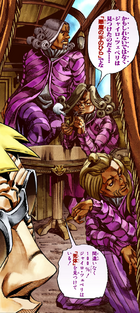
Interviewer: What kind of image do you picture in your head when you draw?
Araki: What I mean to draw. I picture it as a manga drawing, not a live-action picture.
Interviewer: While it's in motion?
Araki: That's correct. During the stage of development where the details haven't been decided upon and I'm still discussing things with my editor, I look at the main character from above in my head. As I gradually enter the world I intend to draw, I begin to see places and situations. And given the personality of the main character, I think about how they would act. For example, if they were caught in an explosion, how would they escape? I imagine it as it would be in the manga.
Interviewer: I see. The black-and-white drawings are wonderful, but the color illustrations are also really beautiful. The colors are very unique.
Araki: I'm a fan of Gauguin. He paints surfaces in vivid color, like painting the ground pink, for example. At the time, I imagine he must've received a lot of criticism and ridicule, but I'm very moved by the fact that he was still able to draw it. So I began to think, "It's alright if I paint it pink, too." That's why I also color lips in blue and add colors that would be unimaginable in reality. I think about colors based on the characters, so anything goes as long as it's appropriate at the time. I compare it with the color sample book, and if I think it matches, I go with pink. And once I decide on pink, I paint the entire surface. For that reason, the anime staff had to ask me what color Jotaro was. Even when I look through the artbooks, the colors are always different. So when they asked, I said, "Oh, any color you like." (laughs). In my case, I can accept any color as long as it suits the screen, but I can't make Jotaro's uniform a different color every time in the anime.
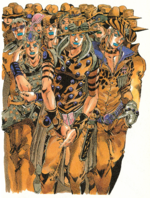
Interviewer: That's something you can only do in manga, isn't it? Araki compositions are all unique, but do you have any rules or preferred ways of drawing?
Araki: There are a few, but I prioritize the story. For instance, in this scene (above, left), Steel is necessary for the flow of the story, so I drew him very large. However, there are also many cases where the characters are each looking in different directions, like in this picture (right). I do this to create a sense of mystery and make the reader ask what each of these people are thinking. I also like to put things front and center, and that's why the characters are drawn so large. That's what gives it depth. Rather than stacking them horizontally, I stack them vertically to create thickness and make the person in front larger. As an example, try holding your finger a little bit in front of the image. That's the kind of thing I value.
Interviewer: Do you have any movements or poses that just feel good to draw?
Araki: I draw unique poses in hopes of leaving a lasting impression. Rather than just standing there, it's more memorable if the characters slightly twist, stick out their fingers, or bend their legs. I wonder whether this image of Gyro (below) had just been sleeping a moment before, but woke up to a feeling that something is wrong.
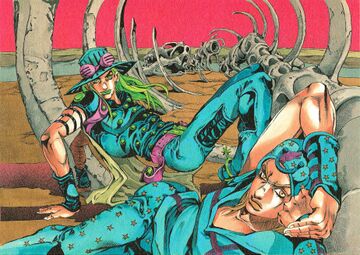
Interviewer: There are some young people who try to imitate JoJo poses.
Araki: I certainly know a lot about yoga (laughs). But the core of it is the twisting. Like with a masterpiece, even though you don't know what's so great about it, there's just something so peculiar about it that it sticks in your mind. I wonder if there's a secret there. That's why I study poses so much. In addition to yoga, I've bought a collection of Bruce Lee's patterns. I think I also studied sculptures at one point. Roman sculptures always have romantic twists and movements.
Interviewer: Even when a character is just standing there, because the art of posing has been so thoroughly studied, the picture is still somehow different from the ordinary, and almost has a perfect beauty to it.
Araki: Venus de Milo is just standing there, and yet there's something peculiar about it. That subtlety is what makes it a masterpiece and a miracle. I wonder how they carved that giant piece of marble, which stood three meters tall, into a piece so perfect from every possible angle. That's why so I'm particular about things like the facial tilt that I take an image I've drawn once, erase just the face, and then tilt it just a little.
Interviewer: I understand. It's been two years since your solo exhibition in France (the article was published in issue S3), but have your feelings towards paintings changed since then?
Araki: My feelings toward paintings haven't changed. The people over there didn't differentiate between manga and art, and I found that kind of reaction amusing. In Japan, people who like artwork tend to distinguish it from manga, but the people there see my drawings as paintings as well. It was certainly a unique feeling, I thought.
Interviewer: Are you planning to hold another solo exhibition?
Araki: I really want to. I feel like an exhibition carries special meaning for both the art and the people who create them.
Interviewer: Perhaps Italy next time? Is it that much more interesting overseas?
Araki: It's very interesting. In Japan, manga fans who know me come to see me, but overseas, the audience is completely different. Old people and passers-by walk in. I held the exhibition in a place that was lined with boutiques, so models and such also appeared. Paris also has a different atmosphere and customer base and such, so it was interesting how different it was from Japan.
Interviewer: Finally, it seems that Part 1 of JoJo's Bizarre Adventure will be released in theaters next year. Please tell us about that as well.
Araki: I checked over the script right up until its completion. If it were just like the manga, the length of it would be unreasonable, and the film wouldn't be cohesive at all. I only made corrections so that I didn't deviate from the theme or what I wanted to convey. I hardly touched the storyboards, though. When it comes to anime, I don't have much insight into, say, voice acting. That much is up to them. But I think the script's good. It's a bit like Peony and Rose (laughs). It's about JoJo and Dio's connection, and it's really interesting.
Interviewer: I'm looking forward to it. The mysteries of Steel Ball Run are slowly being revealed, and I only grow more and more curious about what will happen in the future. Thank you very much for your time today.
[Translated by HudgynS]
Introduction
『ジョジョの奇妙な冒険Part6ストーンオーシャン』の終了より、待ちに待たれての新連載となった『SBR』。北米大陸を乗馬で横断する壮大なレースを舞台に、球体を探る謎めいた男、ジャイロ・ツェペリと今は半身不随となってしまった元天才ジョッキー、ジョニィ・ジョースターを中心に、レースの勝敗とその裏に隠された「史上最大の謎」を巡り、奇妙でスリリングな冒険が展開する。『ジョジョの奇妙な冒険』第一部のパラレルワールドとして描かれる本作では、妖しいスタンド使いや、『ジョジョ』ゆかりのキャラクターも多数登場。そして「ウルトラジャンプ」で開始した2nd.Stageからは、隠されていた謎が次第に暴かれ、物語はさらに大きく動き始める。そんななか、荒木飛呂彦先生へのインタビューをついに敢行!
Interview
――まず、乗馬による北米大陸横断レースという設定が、どのようにして生まれたのか教えてください。
荒木 『ジョジョの奇妙な冒険』の第一部が一八八八年に始まるのですが、第一部と同時代にしたい、と最初に考えました。深い意味はないんだけど、パラレルワールドみたいに、しようと思って。それと同時に、何かを競いながら旅をする、RPGのようにもしたかったんです。それで、この時代はまだ機関車などもできたばかりで馬が主流だったし、レースならRPGの要素もあるだろうと思って、アメリカ大陸を乗馬で横断するレースに、ジョジョのキャラクターが絡んでいく話にしました。
――なるほど。マウンテン・ティムのカウボーイ風のコスチュームや、砂漠を馬で走る描写など、物語全体にウェスタンのムードを感じますが、これも時代にあわせて?
荒木 それもありますが、ウェスタンは僕のルーツなんです。デビュー作(『武装ポーカー』)もウェスタンだし、少年時代は『スターウォーズ』よりもクリント・イーストウッドに夢中でしたから。ファッションも好きだしね。あとは「砂漠に一人立っている」という情景を思い浮かべるだけで、もう涙がでてくる。あのアウトローな感じが、すごく好きで。承太郎もそうだけど、バビル2世(『バビル2世』横山光輝)が学生服を着て砂漠の地平線に立っている姿とか、かっこいいんですよ。少年時代に心を燃やした、自分のルーツだからでしょうね。
――キャラクターのコスチュームも、ウェスタンのイメージから?
荒木 時代考証や細かいところは抜きにして、エスニックや自然の要素を取り入れたファッションにしています。あとはヒョウ柄やファーみたいなもの、ガンベルトやブーツとかね。好きなんですよ。
――『SBR』は『ジョジョ』のように「過去の因縁」や「戦い」が前面にくる感じではなくて、最初のうちは、あくまでレースメインという感じがしますよね。
荒木 そうなんだよね。最初は誰か勝つのか予測がつかないレースをやりながら、徐々に謎が暴かれていくという物語を目指しました。だけど、描いているうちにジャイロやジョニィ・ジョースターが主人公になるような展開になってきたのかな。そのへんはあまり計算してなかったんですけどね。
――ジャイロもジョニィもすごく魅力的ですよね!最初は、二人で協力して勝利を目指して、その過程の一つとして敵との戦いがあるのかと思っていましたが、実はレースの裏に何か大きな陰謀がある、というのが見えてきましたね。
荒木 ただのレースじゃない、というのを描きたくて。とくに「ウルトラジャンプ」では、物語やキャラクターが、さらに深く暴かれていきます。人類史上最大のすごい謎がある、という感じ(笑)。ただ、あまり謎で読者を引っ張るのはよくないので、答えは早い段階でバンと出しておいて、キャラクターの魅力で見せていきたいですね。
――ジャイロとジョニィのコンビは素敵ですよね。ジョニィは歴代ジョジョと違って、最初から力があるわけじゃないし足も動かないし、これまでの主人公像とは少し異質な感じがします。
荒木 ジャイロは完成されていて、背後に何か謎を持っている。それに対してジョニィはジャイロからどんどん学んでいく、というタイプ。ジョニィがレースを通じて成長していく魅力を描こうと思っています。二人を対比して描いてるんです。そしてジョニィの成長する過程がレースの謎を暴いていくことにもなります。
――なるほど。ジャイロが球体を使い、ジョニィのスタンドが肉体や物体を回転させる能力ですが、「回転」や「球体」はポイントでしょうか。
荒木 いつも主人公たちの能力には、テーマがあるんですよ。例えば「命を蘇らせる」とか、徐倫なら糸っぽい感じとか。今回の球体は無限のイメージがあるし、色々な応用が利くかと思って決めました。それにボールを見たら「SBRだな」と思ってもらえるような、集中したテーマが必要だと思うし。そして作品の本質的なテーマにも繋がります。
――『SBR』では馬がたくさん描かれてますが、躍動感や迫力がすごいですよね。描いていて、いかがですか。
荒木 楽しいですが、馬とのバランスで乗った人間が小さく見えるので、ちょっと大変ですね。顔を見せたいけど馬に乗っている感じも見せたいし。映画みたいな大画面だったらいいけど、原稿用紙の決められた面積だと、すごく大変です。ただ、描くのは本当に楽しいし、パワーがもらえる。ゲームで、「キャラクターが動物に乗ると強くなる」というシステムがありますが、そういう感じです。
――レオナルド・ダ・ヴィンチなど、古典画家も馬をモチーフにした作品を多数描いてますが、絵としても描き甲斐があるんでしょうね。
荒木 馬が歴史とすごく密接に関わっていたというのもあるでしょうね。勝利の象徴みたいな意味があるらしくて、敵に勝ったら銅像にして飾ったらしいですから。絵としても、もちろん面白いですよ。筋肉の付き方が美しいなぁ、とか。前足と後ろ足をどう動かして走るんだろう、とか。間接の曲がり方はどうで、ジャンプするときはまた違う、とかね。そういうのを考えながら描くのは面白いです。
――荒木さんは、『ジョジョ』でもそうですが、実際にはあり得ない、想像しがたい場面をすごくリアルに描かれますよね。ジョニィの爪の先がクルクル回ったりする場面(※P一六・図三参照)もすごく詳細に描写されてて。
荒木 それが漫画の魅力の一つですよね。以前に石が虫に変身するシーンを『ジョジョ』で描いたのですが、「『ジョジョ』の絵のほうがCGの映像でやるよりリアルですね」って言われたこともあります。それから肉体が変化する様を描くのが好きなんですよ。殴られて、顔が歪んでいく場面などを描いていると楽しくて。残酷描写と取る人もいますが、僕の場合は肉体をパズルのような感覚で描いてます。
――描くときに頭の中で想像してる映像は、どんなものですか。
荒木 あの通り。実写じゃなくて漫画の絵で想像しています。
――動いてる状態で、ですか。
荒木 そうなんですよ。まだ担当と打ち合わせをしているような、細かい展開などが決まってない段階で、頭の中で主人公を上空から見るんです。だんだん自分の描いた世界に入りこんでいくと、場所や状況が見えてくる。それで、この主人公の性格なら、どう行動するか、と考えます。例えば爆発が起きたら、どう逃げるだろう、とか。それを漫画の通りにイメージしていくんです。
――なるほど。モノクロの描写も素晴らしいですが、カラーイラストも本当にキレイですよね。色遣いも独特で。
荒木 僕はゴーギャンが好きなんです。あの人は色を面で塗るのですが、例えば地面をピンクで塗ったりする。当時は散々、批判や嘲笑を受けたようですが、それでも描くというところに、すごく感動して。それで「ピンクに塗ってもいいんだ」と思いましたね。だから、僕も唇をブルーににしたり、現実には考えられない色も載せます。色は人物に合わせて考えるので、その時々で合っていればいいんです。色の見本帳と照らして、合うと思えばピンクにする。「ピンク」と決めたら面全体を塗っていきます。そういう感じだから、アニメのスタッフにも「承太郎って何色ですか」と聞かれたりしました。画集を見ても、いつも色がパラパラだしね。そのときは「あ、何色でもいいです」と言うんですけど(笑)。僕の場合は、画面に合ってれば何色でもいいのですが、アニメで承太郎の制服を毎回違う色にするわけには、いかないですからね。
――漫画ならではの表現ですよね。荒木さんは構図も独特ですが、何か法則だとか、気持ちいい描き方があるのでしょうか。
荒木 一応あるけど、ストーリー優先です。このシーン(※P一七・下図参照)もスティールというキャラクターがストーリーの流れで必要だから、大きく描いているんす。ただ確かに、この絵のようにキャラクターが全員、別の方向を見てることは多いですね。これは「こいつら何を考えるんだろう」と謎めいた感じを出す意味でやっています。あとは、手前にモノを置くのが好きです。だからキャラクターも、でっかくガーンと置く。そうすると奥行きが出るんです。横並びでなく、縦に重ねて厚みを出して、前に出てくる人を大きくします。その手前にも、例えば、ちょっと指を入れてみたりね。そういうのが好きです。
――動きやポーズを描いていて気持ちいい絵があるんですか。
荒木 独特なポーズを描くのは印象に残るように、という願いです。普通に立ってるよりも、微妙にねじったり指を入れたり、足をクッと曲げたりするほうが、心に残るから。このジャイロ(※「ウルトラジャンプ」見開きカラー。P一二、三扉参照)も、ただ寝てるだけじゃなくて、ちょっと起きあがろうとしたら、何かあるような感じがするかな、とかね。
――ジョジョのポーズを真似する若者もいますよね。
荒木 確かにヨガの研究なども、しましたから(笑)。でも、「ねじり」が基本です。名画も、どこが良いのかわからないのに心に残るのは、きっと何かが変だからだと思うんです。そこに秘密があるんじゃないかな。だからポーズは、すごく研究しています。ヨガの他には、ブルース・リーの型集なども買いました。あと彫刻も研究したかな。ローマの彫刻には、必ず「ねじり」が入って、動きがロマンチックなんです。
――ポーズをそれだけ研究されてるから、キャラクターがただ立ってるだけでも、どこか普通とは違って絵になるし、完成された美があるんでしょうね。
荒木 ミロのヴィーナスもただ立ってるだけなのに何かが違うんですよ。その微妙なところが名作だし、奇跡ですよね。三mもあるような巨人な大理石を、どうやって彫ったのかと思いますけど、三六〇度、どこから見ても完璧なんです。だから、僕も顔をちょっと傾けたいな、とか色々とこだわりがあって、一回描いた絵を顔の部分だけ消して、傾けたりしてます。
――なるほど。フランスでの個展(取材記事をS三号に掲載)から二年経ちますが、あのときから、絵に対する気持ちも変わってきたのでしょうか。
荒木 絵に対する気持ちは変わらないですね。向こうの人は漫画と絵を区別してなくて、そういった反応は面白がったですけど。日本だと、絵が好きな人は漫画を区別するようなイメージがあるけど、向こうの人は僕の絵も絵画としてみるんです。違う感覚だなぁ、と思いました。
――また個展をされる気は?
荒木 やりたいですねぇ。展覧会は絵と描く人間には意味があると感じます。
――今度はイタリアとか?海外のほうが面白いですか?
荒木 面白いというか、日本だと僕を知っている漫画ファンが来てくれるけど、海外だと、客層が全然、違うんですよ。歳を召された方も、通行人も入ってくる。僕はブティックが建ち並ぶような場所でやったから、モデルみたいな人も来てね。パリも場所によって雰囲気も客層も様々だから、日本と感覚が違って、面白かったですね。
――最後に、来年、『ジョジョの奇妙な冒険』第一部のアニメが劇場公開されるそうですが、それについても教えてください。
荒木 脚本の完成までは僕もチェックしています。漫画そのままだと、長さとして無理があるし、まとまりが良くないですから。「テーマ」や「描きたいこと」から外れないよう、直していきました。絵コンテなどは、ほとんどタッチしていません。アニメとなると、例えば声優などに関しても、あまりイメージが湧かなくて。その辺りは、お任せです。でも良い脚本になってると思います。ちょっと『牡丹と薔薇』っぽい(笑)。『ジョジョとディオの因縁』みたいな。すごく面白いですよね。
――楽しみですね。『SBR』もじわじわと、謎が暴かれていき、今後の展開がますます気になります。今日は本当にありがとうございました。
